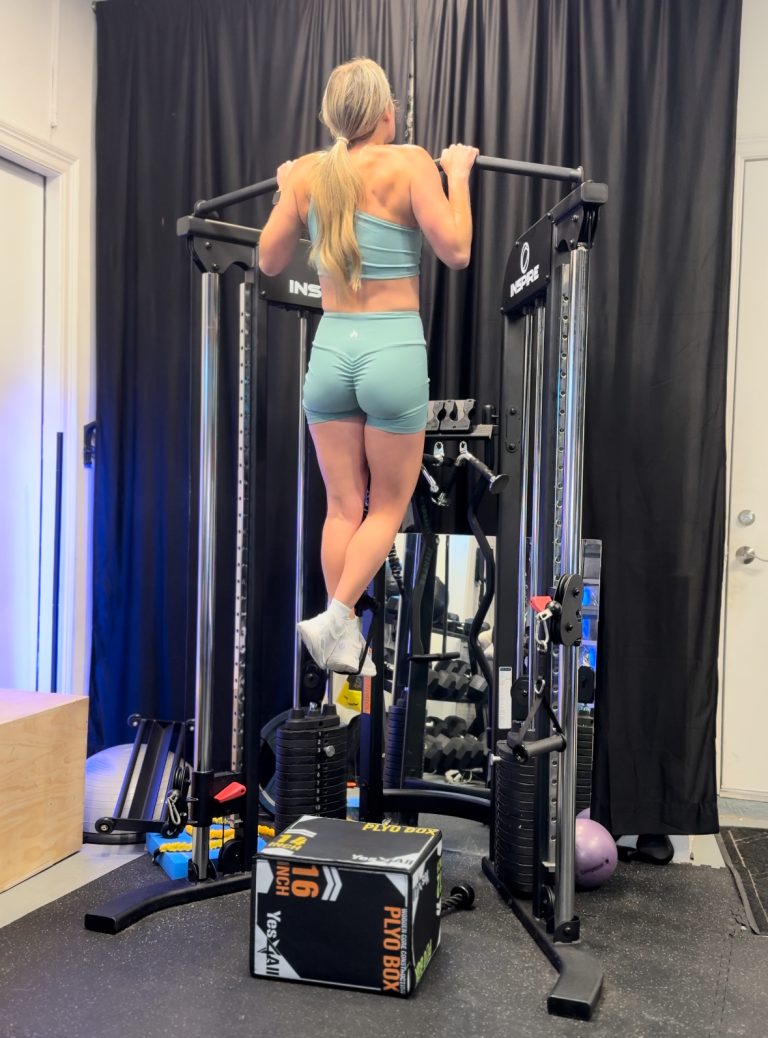How To Achieve Your First Pull Up
Ever dreamt of mastering the pull-up but feel lost on where to begin? Look no further! Welcome to your ultimate guide. Let’s dissect every aspect and propel you towards conquering that elusive first pull-up! Let’s dive in and make that dream a reality!

First, What Is Being Activated During a Pull Up?

When it comes to pull ups, your palms are facing away from you with an overhand grip on the bar. This requires shoulder adduction (squeezing shoulders towards centerline) and requires muscles such as:
- Back Muscles:
- Lats (the v in your back)
- Rhomboids (upper-back by shoulder blades)
- Traps (mid-back by shoulder blades)
- Shoulder Muscles:
- Posterior Deltoids (backs of shoulders)
- Arm Muscles:
- Brachialis (elbow flexor by the bicep)
It’s important to understand what is being activated so in addition to this pull up regression, you include exercises that work these muscles in order to get stronger and allow you to actually pull your body weight up! Here is my progression:
When it comes to lat pull downs, you can do these at the gym on a lat pull down machine, using a cable machine, or even using resistance bands with handles. What a lat pull down essentially is is an “inverted pull up” where you’re pulling your body weight down to your chest (or attempting to work your way up to your body weight). I’d start with this exercise until you can get 6 reps with your body weight ensuring you have correct and proper form!
Step 1: Lat Pull Downs
Step 2: Inverted Rows
Although inverted rows on a barbell or smith machine are similar to a chin up, it recruits and requires the same, if not not more, muscles used in a pull up, and allows you to move the bar down based on how strong you are. The higher the bar is anchored, the less load your body is pulling towards the bar (think the opposite of an elevated push up), so you can begin this at any level.. Inverted rows also help increase grip strength needed to support you in pull ups, as well as improve scapular retraction required as well!
HOW TO: Walk out with an underhand grip on the bar with your body in one straight line like you are performing a push up, with your glutes and hamstrings activated and arms extended right in front of you, palms facing up. Keeping your body in one straight line with your heels down, toes up, exhale as you drive your elbows straight back utilizing your back muscles to pull your chest to touch the bar in front of you, and then inhale as you return back to your starting position.
Tip For Incorporating In Workouts: Start at the highest height you can successfully pull your chest to the bar for ten reps with, and then move the bar down one slot and perform the most amount of reps you can with solid form until you reach ten, and repeat the process until you get as low as possible!
If you do not have access to a barbell or smith machine at your gym, incorporate dumbbell low rows and work your way up in weight to activate and strengthen your lats, traps, wrists, forearms, and biceps.
3. Eccentric Only Pull Ups
Once you can successfully achieve band-assisted pull ups, now is time to add power to your pull ups and practice on working on the hardest part of the pull up, the lowering phase! To do this, use a box and jump to so your chin reaches the top of the bar and then slowly lower your body down for the count of 5 seconds
Try 3 rounds of 2-6 reps each! If you find you don’t have the grip strength and overall strength to lower your body down with control, keep working on the steps below and you can even try this with a band to help you feel more supported until your are able to do the pull up without one!
When Conquering The Bodyweight Pull Up:
1. Try not to use momentum to get your chest to the bar, but rather utilizing the muscles you have strengthened in the previous exercises.
2. Draw your shoulders down and back before starting the pull up.
3. Lower yourself down with control until your arms are completely straight before attempting at another rep.
Looking for accountability, along with a workout regimen & nutrition plan that works around YOUR schedule, time-commitment, & overall goals?
Look no further. Click below to find out more about Mess In Progress programs!
